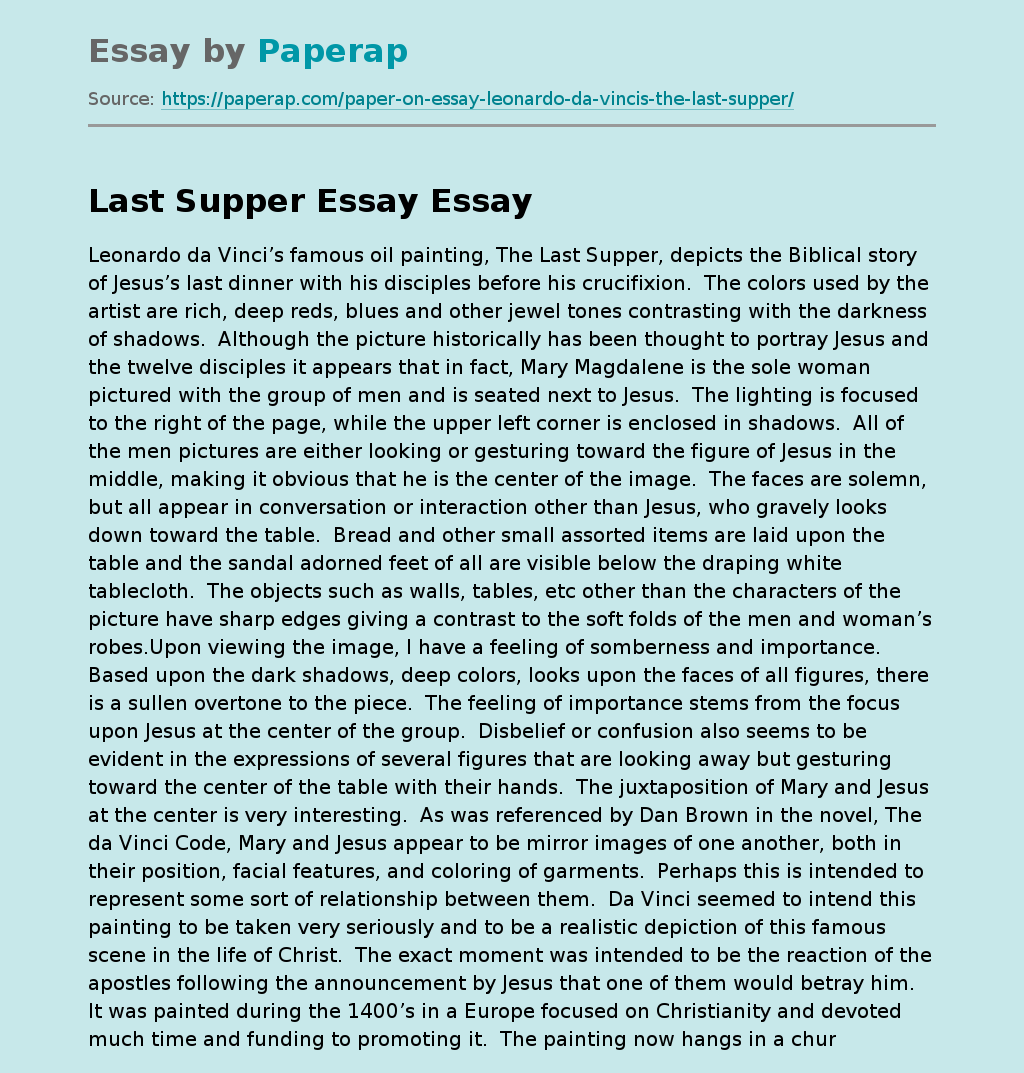Leonardo Da Vinci’s Famous Oil Painting the Last Supper
The following sample essay focuses on Leonardo da Vinci’s famous oil painting The Last Supper. Read the introduction, body and conclusion of the essay, scroll down.
Leonardo da Vinci’s famous oil painting, The Last Supper, depicts the Biblical story of Jesus’s last dinner with his disciples before his crucifixion. The colors used by the artist are rich, deep reds, blues and other jewel tones contrasting with the darkness of shadows. Although the picture historically has been thought to portray Jesus and the twelve disciples it appears that in fact, Mary Magdalene is the sole woman pictured with the group of men and is seated next to Jesus.
The lighting is focused to the right of the page, while the upper left corner is enclosed in shadows. All of the men pictures are either looking or gesturing toward the figure of Jesus in the middle, making it obvious that he is the center of the image.
The faces are solemn, but all appear in conversation or interaction other than Jesus, who gravely looks down toward the table.
Bread and other small assorted items are laid upon the table and the sandal adorned feet of all are visible below the draping white tablecloth. The objects such as walls, tables, etc other than the characters of the picture have sharp edges giving a contrast to the soft folds of the men and woman’s robes.Upon viewing the image, I have a feeling of somberness and importance. Based upon the dark shadows, deep colors, looks upon the faces of all figures, there is a sullen overtone to the piece.
The feeling of importance stems from the focus upon Jesus at the center of the group. Disbelief or confusion also seems to be evident in the expressions of several figures that are looking away but gesturing toward the center of the table with their hands.
The juxtaposition of Mary and Jesus at the center is very interesting. As was referenced by Dan Brown in the novel, The da Vinci Code, Mary and Jesus appear to be mirror images of one another, both in their position, facial features, and coloring of garments. Perhaps this is intended to represent some sort of relationship between them. Da Vinci seemed to intend this painting to be taken very seriously and to be a realistic depiction of this famous scene in the life of Christ. The exact moment was intended to be the reaction of the apostles following the announcement by Jesus that one of them would betray him. It was painted during the 1400’s in a Europe focused on Christianity and devoted much time and funding to promoting it. The painting now hangs in a church in Milan where it may be viewed for only a short time, due to the work’s delicate nature and multiple needs for restoration. The fact that is shown within a church, gives it even more weight in being a historical representation of what is regarded to be truth by the church.Being created during this religious era, the work was obviously influenced by the importance of Christianity in society at the time.
If the character, who appears to be Mary, is in fact her and not one of the disciples, this would give that particular element of the picture a completely different meaning. While it may not have been influenced by a particular belief of da Vinci’s that Mary was equally important to Jesus, as has been fictionalized, it may mean simply that da Vinci found her to have an important role in the last days of Christ. It is important to be aware of both possibilities when viewing this work, so as to not be biased since there is no definitive answer regarding that figure’s sex. However, how an individual perceives art will never be identical to another’s perception. Thus, there is no exact meaning to attribute to this lack or existence of Mary.As a work of art, this painting has a high value. It was composed by one of the greatest master artists of all time and is one of his most famous works. The image is captured very realistically, and the use of color, tone, and figure placement adeptly conveys the tone and feeling. The embodiment of an important part of Christianity and the fact that it has remained so highly regarded and admired 600 years after its rendering, only amplify The Last Supper’s value to the art community.
Leonardo Da Vinci’s Famous Oil Painting the Last Supper. (2019, Dec 05). Retrieved from https://paperap.com/paper-on-essay-leonardo-da-vincis-the-last-supper/

